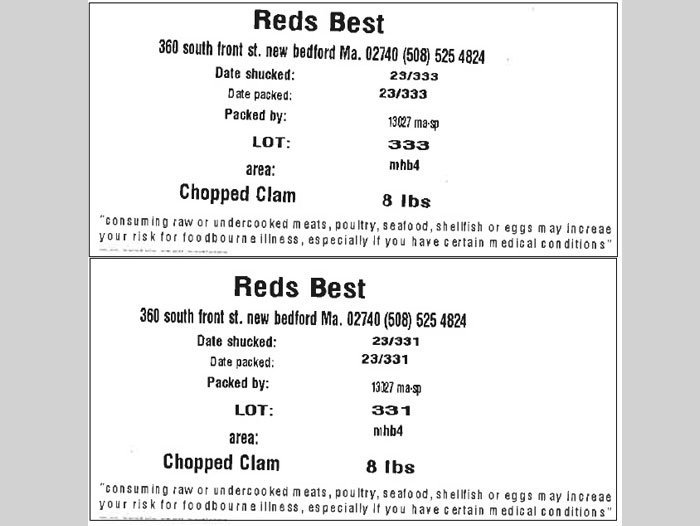FDA Advises Restaurants and Retailers Not to Serve or Sell and Consumers Not to Eat Certain Chopped Clams Likely Harvested from a Prohibited Area in Massachusetts and Distributed by Red’s Best
December 13, 2023 | 4 min to read
Restaurants and retailers in Connecticut, Massachusetts, New York, and Rhode Island are urged by the FDA to avoid selling or consuming Red’s Best chopped clams from lots # 331 and # 333, harvested from prohibited waters on 11/25 and 11/26, 2023, due to potential contamination. Symptoms of food poisoning may occur, including diarrhea and nausea. Those affected should seek medical attention and report symptoms to health authorities.

Audience
- Restaurants and food retailers in Connecticut (CT), Massachusetts (MA), New York (NY), and Rhode Island (RI) that have recently purchased Red’s Best chopped clams, labeled as lot numbers # 331 and # 333, with shuck dates of 23/331 and 23/333. These clams were likely harvested from prohibited waters in MA on 11/25/2023 and 11/26/2023.
- Consumers in CT, MA, NY, and RI who have recently purchased or consumed Red’s Best chopped clams, labeled as lot numbers # 331 and # 333, with shuck dates of 23/331 and 23/333, that were likely harvested from prohibited waters in MA on 11/25/2023 and 11/26/2023.
Product
Certain chopped clams likely harvested from prohibited waters in MA on 11/25/2023 and 11/26/2023 and distributed to CT, MA, NY, and RI. It is possible that chopped clams may have been distributed to other states as well. These clams were included in two lots of Red’s Best chopped clams and can be identified by lot numbers # 331 and # 333, with shuck dates of 23/331 and 23/333 and harvest area mhb4, packed by 13027 ma-sp. The affected chopped clams were packed in one-gallon (8 lbs) plastic containers with “Red’s Best” printed on the sidewall. Both the lot number and shuck date should be printed on a decal label adhered to either the lid or sidewall of each container.
Purpose
The US Food and Drug Administration (FDA) is advising consumers not to eat, and restaurants and food retailers not to sell, and to dispose of Red’s Best chopped clams likely harvested from prohibited waters in MA on 11/25/2023 and 11/26/2023 with lot numbers # 331 and # 333, and shuck dates of 23/331 and 23/333, because they may be contaminated. The chopped clams were directly distributed to distributors and retailers in CT, MA, NY, and RI and may have been distributed further from these states.
Clams harvested from prohibited waters may be contaminated with human pathogens, toxic elements or poisonous or deleterious substances and can cause illness if consumed. Clams are filter feeders that remove and bioaccumulate bacteria and other pathogens from the water. It is not uncommon for shellfish to be consumed raw and whole. Contaminated clams can cause illness if eaten raw, particularly in people with compromised immune systems. Clams contaminated with pathogens may look, smell, and taste normal.
Symptoms of Food Poisoning
People can get sick with food poisoning after ingesting pathogens, toxic elements, or poisonous or deleterious substances. Symptoms may vary, depending on the pathogen or contaminant and can range from mild to serious. The most common symptoms of food poisoning are diarrhea, stomach pain or cramps, nausea, vomiting, and fever. Symptoms may start within a few hours or may take a few days and can last for a few hours or several days. Consumers of these products who are experiencing food poisoning symptoms such as diarrhea, stomach pain or cramps, nausea, vomiting, or fever should contact their healthcare provider, who should report their symptoms to their local Health Department.
Summary of Problem and Scope
On 12/11/2023, the Massachusetts Department of Public Health informed the FDA of a recall of two lots of Red’s Best chopped clams that had been likely harvested from a prohibited area and potentially contaminated. The clams were likely harvested from prohibited waters in MA on 11/25/2023 and 11/26/2023. Clams were directly distributed to distributors and retailers in CT, MA, NY, and RI and may have been distributed further from these states.
FDA Actions
The FDA is issuing this alert advising consumers not to eat, and restaurants and food retailers not to sell, Red’s Best chopped clams labeled as lot numbers # 331 and # 333, from harvest area mhb4 with shuck dates of 23/331 and 23/333 likely harvested from prohibited waters in MA on 11/25/2023 and 11/26/2023. The FDA is awaiting further information on distribution of the chopped clams and will continue to monitor the investigation and provide assistance to state authorities as needed.
Recommendations for Restaurants and Retailers
Restaurants and retailers should not serve or sell the potentially contaminated clams. Restaurants and retailers should dispose of any products by throwing them in the garbage or returning them to their distributor for destruction.
Restaurants and retailers should also be aware that shellfish may be a source of pathogens and should control the potential for cross-contamination of food processing equipment and the food processing environment. They should follow the steps below:
- Wash hands with warm water and soap following the cleaning and sanitation process.
- Retailers, restaurants, and other food service operators who have processed and packaged any potentially contaminated products need to be concerned about cross-contamination of cutting surfaces and utensils through contact with the potentially contaminated products.
- Retailers that have sold bulk product should clean and sanitize the containers used to hold the product.
- Regular frequent cleaning and sanitizing of food contact surfaces and utensils used in food preparation may help to minimize the likelihood of cross-contamination.
Recommendations for Consumers
Consumers should not eat the potentially contaminated clams. Consumers who have symptoms should contact their health care provider to report their symptoms and receive care.
